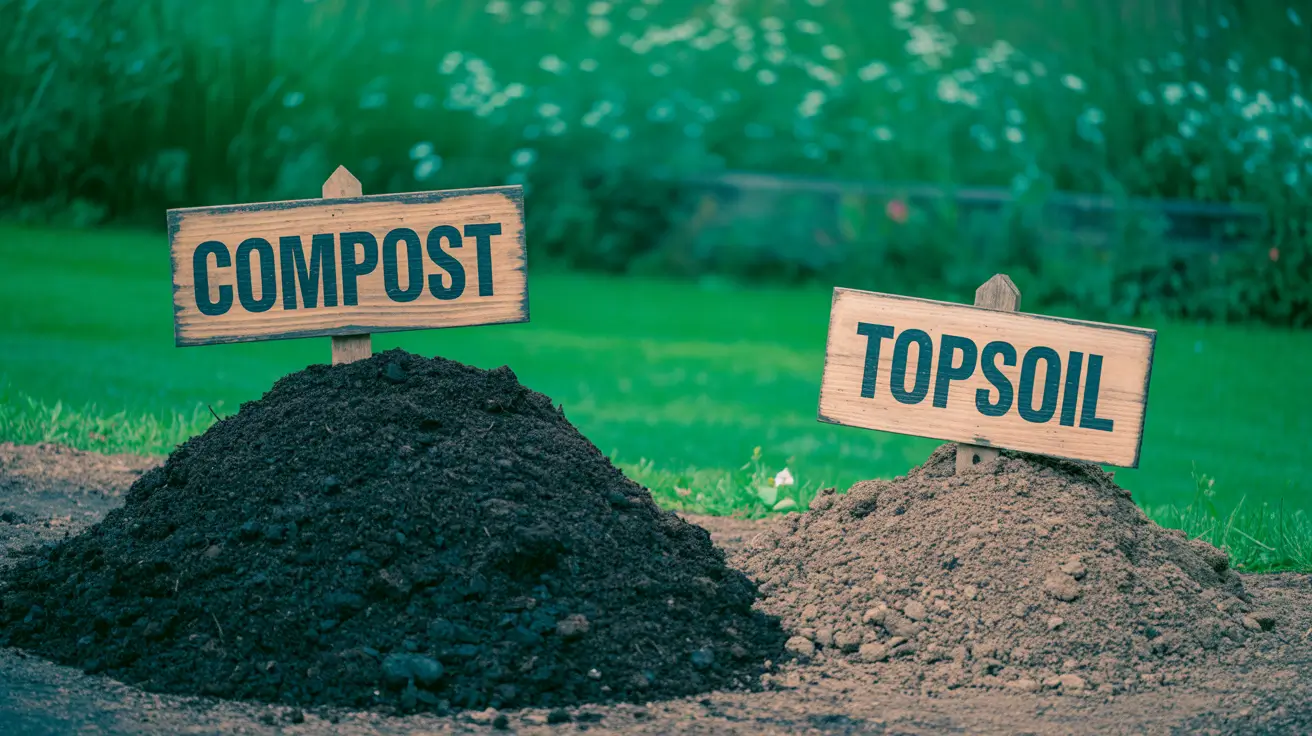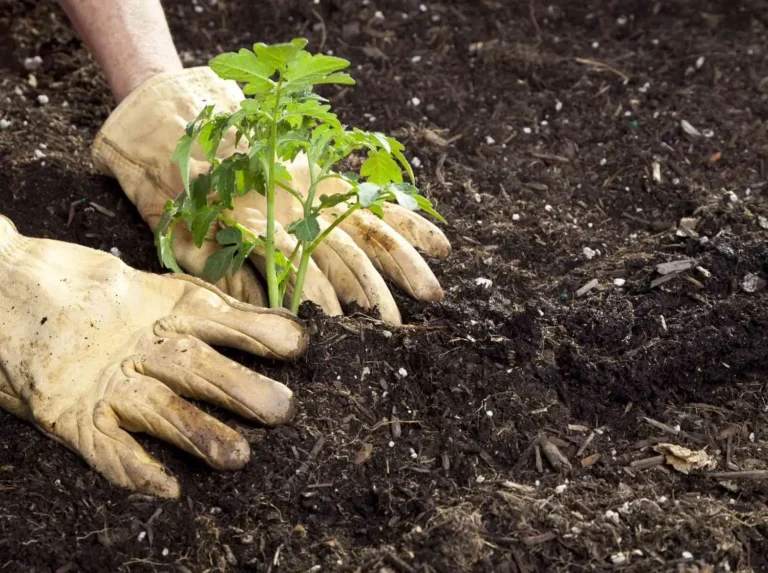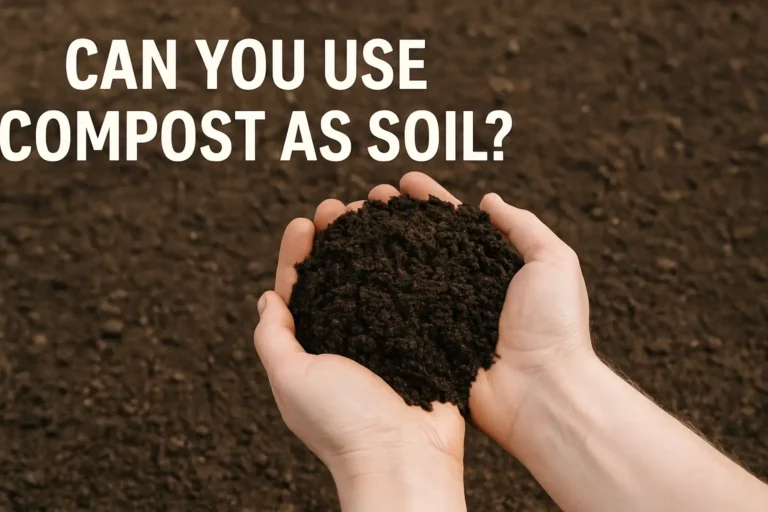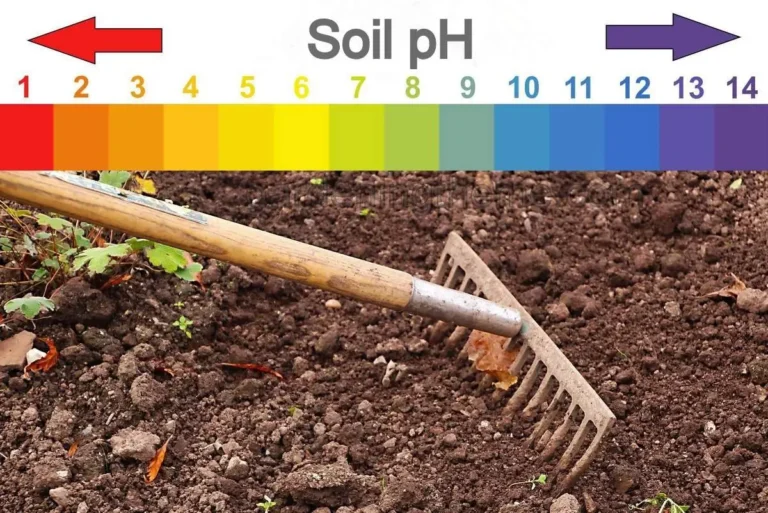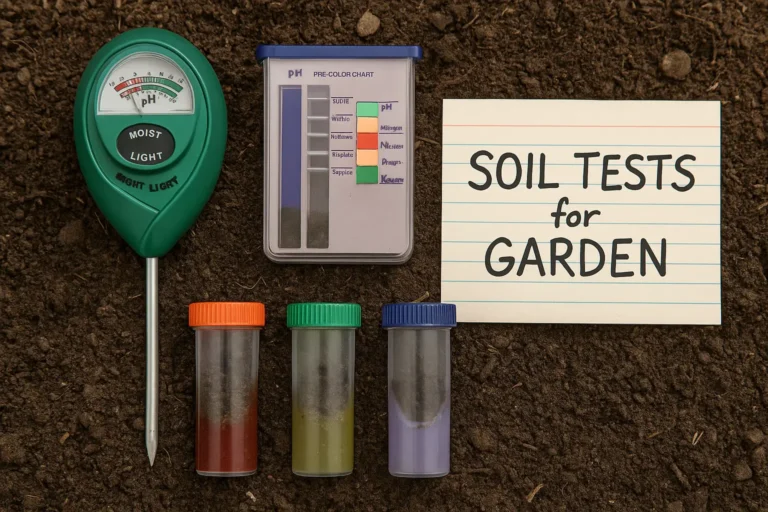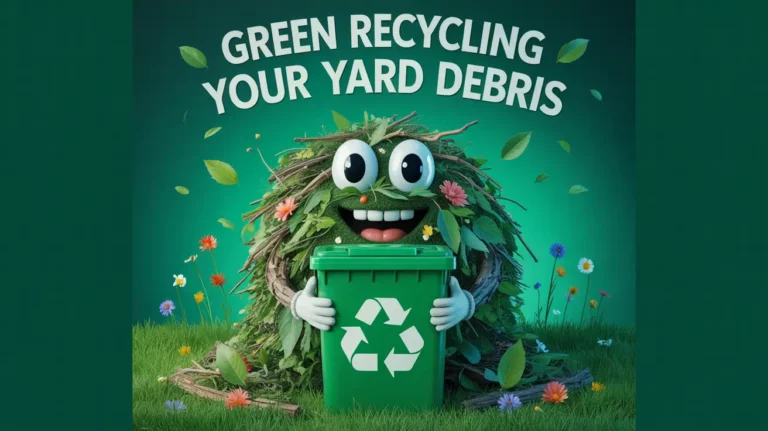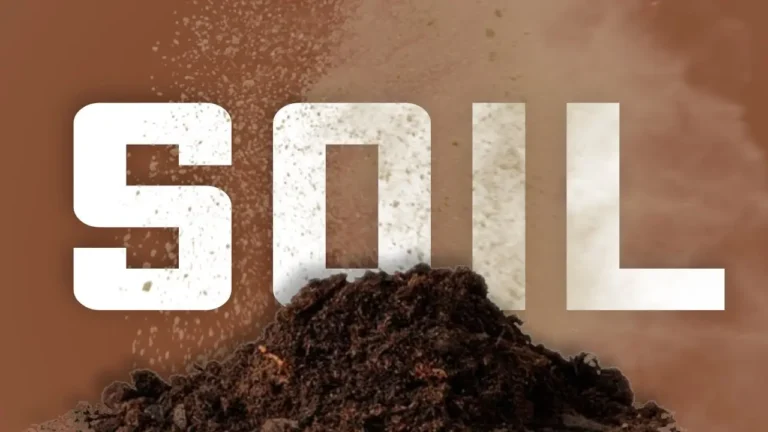Topsoil vs Compost for Lawn: Choosing the Right Soil Amendment for Your Perfect Lawn
When it comes to creating a lush, healthy lawn that becomes the envy of your neighborhood, the choice between compost and topsoil can make or break your landscaping success. This comprehensive guide cuts through the confusion to deliver the definitive answer on compost vs topsoil for lawn applications, helping you make the smart choice that saves money while delivering exceptional results.
Whether you’re establishing a new lawn, fixing patchy areas, or enhancing your existing grass, understanding the distinct roles of compost and topsoil is crucial for achieving professional-quality results. Let’s dive deep into everything you need to know about these essential soil amendments.
Understanding the Fundamentals: What Exactly Are Compost and Topsoil?
What Is Compost and Why Your Lawn Craves It
Compost represents nature’s most powerful soil enhancer—a nutrient-rich, organic material created through the controlled decomposition of organic matter like grass clippings, fallen leaves, kitchen scraps, and yard waste. This biological transformation process creates a dark, crumbly substance teeming with beneficial microorganisms that dramatically improve soil health.
The magic of compost lies in its ability to transform any lawn from ordinary to extraordinary. Unlike synthetic fertilizers that provide a quick nutrient rush followed by a crash, compost delivers slow-release nutrition while simultaneously improving soil structure, water retention, and microbial activity.
High-quality compost typically contains essential nutrients including nitrogen, phosphorus, and potassium, plus trace minerals that grass needs for optimal growth. More importantly, it introduces billions of beneficial bacteria and fungi that create a thriving soil ecosystem supporting long-term lawn health.
What Is Topsoil and When Your Lawn Needs It
Topsoil represents the uppermost layer of earth—typically the top 5-10 inches—where most biological activity occurs. When purchased for landscaping purposes, quality topsoil contains a balanced mixture of sand, silt, clay, and organic matter that provides the physical foundation for plant growth.
The primary function of topsoil extends beyond mere soil volume. Premium topsoil offers proper drainage characteristics, adequate nutrient levels, and the structural integrity necessary for root development. However, not all topsoil delivers equal value—quality varies dramatically based on source, composition, and processing methods.
Understanding soil types and their impact on plants becomes crucial when selecting topsoil, as different grass varieties thrive in different soil compositions.
The Science Behind Soil Health: How Compost and Topsoil Impact Your Lawn
The Organic Matter Advantage: Why Compost Transforms Lawns
Organic matter content serves as the foundation of healthy soil, and compost delivers this essential component in abundance. Research consistently demonstrates that lawns with 3-5% organic matter content exhibit superior water retention, reduced runoff, enhanced nutrient availability, and increased resistance to environmental stress.
Compost improves soil structure through aggregation—the process where soil particles bind together creating stable crumbs that enhance air and water movement. This improved structure prevents compaction, reduces erosion, and creates the ideal environment for deep root development.
The microbial activity introduced by compost creates a living soil ecosystem. These beneficial microorganisms break down organic matter, release nutrients in forms readily available to grass, suppress harmful pathogens, and improve overall soil health through complex biological processes.
Additionally, compost acts as a pH buffer, helping maintain optimal soil acidity levels for grass growth while providing slow-release nutrition that feeds your lawn consistently throughout the growing season.
The Structural Foundation: How Topsoil Supports Lawn Establishment
Quality topsoil provides the physical foundation necessary for successful lawn establishment and maintenance. The ideal topsoil composition—approximately 40% sand, 40% silt, and 20% clay—creates optimal drainage while maintaining adequate moisture retention.
Topsoil density and porosity directly impact root development and nutrient uptake. Well-structured topsoil allows roots to penetrate deeply, accessing water and nutrients while providing the stability necessary for healthy grass establishment.
The mineral content in quality topsoil supplies essential nutrients including potassium, phosphorus, calcium, and trace elements that support various physiological processes in grass plants. These minerals become particularly important in areas with naturally poor soil conditions.
Compost vs Topsoil for Lawn: Comprehensive Application Guide
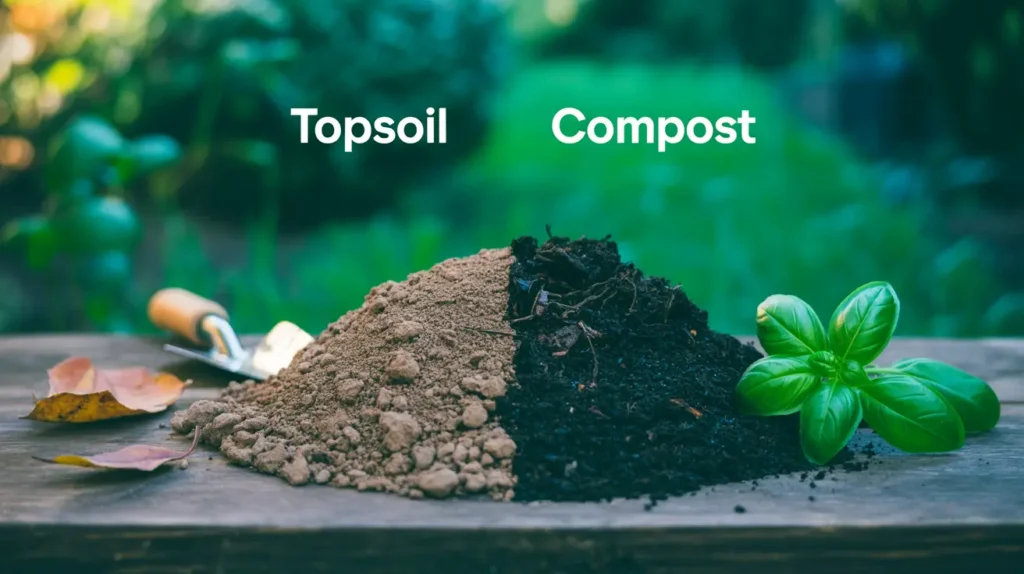
When Compost Reigns Supreme: Perfect Applications
Existing Lawn Enhancement and Top Dressing
Compost excels as a top dressing material for established lawns, providing the perfect solution for enhancing soil health without disrupting existing grass. Apply a thin layer (¼ to ½ inch) of quality compost across your entire lawn during spring or fall for maximum benefit.
The gradual decomposition of compost continues feeding your lawn throughout the growing season while improving soil structure and water retention. This application method proves particularly effective for lawns suffering from compaction, poor drainage, or nutrient deficiencies.
Overseeding and Patch Repair Projects
When overseeding thin areas or repairing bare patches, compost provides the ideal growing medium for new grass establishment. Mix compost with existing soil to create an enriched environment that promotes rapid germination and strong seedling development.
The water retention properties of compost keep seeds consistently moist during the critical germination period, while the nutrient content provides immediate nutrition for emerging grass plants.
Clay Soil Improvement and Drainage Enhancement
Lawns established on heavy clay soil benefit tremendously from regular compost applications. The organic matter gradually improves soil structure, creating aggregation that enhances drainage and reduces compaction issues common in clay soils.
Consistent compost applications transform problematic clay soil into a thriving growing medium that supports healthy grass development while preventing the waterlogging that kills grass roots.
When Topsoil Takes the Lead: Essential Applications
New Lawn Installation and Major Renovations
Large-scale lawn installations require substantial soil volume, making quality topsoil the practical choice for establishing the growing medium foundation. When installing new sod or seeding large areas, topsoil provides the bulk material necessary for proper lawn establishment.
Calculate your topsoil needs using our comprehensive topsoil calculator to ensure adequate coverage for your specific project requirements.
Leveling and Grading Applications
Topsoil serves as the primary material for correcting grade issues, filling low spots, and creating the level surface necessary for professional-quality lawn installation. The density and composition of quality topsoil provide stable leveling that won’t settle unevenly over time.
Unlike compost, which continues decomposing and settling, properly prepared topsoil maintains its level and provides the permanent foundation necessary for long-term lawn success.
Volume Requirements and Large Area Coverage
When projects require significant soil volume—such as raised lawn areas or major landscape renovation—topsoil delivers cost-effective coverage that compost cannot match economically. The bulk pricing of quality topsoil makes it the practical choice for extensive coverage requirements.
The Perfect Partnership: Combining Compost and Topsoil for Maximum Results
Creating the Ultimate Lawn Growing Medium
The most successful lawn installations and renovations combine both compost and topsoil in strategic ratios that leverage the strengths of each material. This approach maximizes both immediate results and long-term lawn health.
The Professional Blend Formula
Mix quality topsoil with compost at a ratio of 70% topsoil to 30% compost for new lawn installations. This combination provides adequate soil volume and structural integrity while delivering the organic matter and nutrient benefits of compost.
For existing lawn enhancement, alternate between compost top dressing applications and targeted topsoil additions based on specific lawn needs and problem areas.
Timing and Application Strategies
Apply compost-topsoil blends during optimal growing periods—early spring or early fall—when grass can effectively utilize added nutrients and establish in improved soil conditions. Avoid applications during dormant periods or extreme weather conditions.
The sequential approach proves most effective: establish the foundation with quality topsoil, then maintain and enhance with regular compost applications throughout the growing season.
Seasonal Application Guide: When and How to Apply Each Material
Spring Applications: Setting the Foundation for Success
Spring represents the optimal time for major soil amendments as grass emerges from dormancy and begins active growth. The warming soil temperatures and increasing moisture create ideal conditions for both material application and grass response.
Early Spring Compost Top Dressing (March-April)
Apply compost as a top dressing when grass begins showing new growth but before the peak growing season begins. This timing allows the organic matter to integrate with existing soil while providing nutrition for spring growth.
Use high-quality compost screened to ¼ inch or finer to ensure even distribution and prevent interference with mowing operations. Application rates of ¼ to ½ inch provide optimal results without overwhelming existing grass.
Late Spring Topsoil Applications (April-May)
Major topsoil applications work best in late spring when soil moisture levels stabilize and grass enters active growth phase. This timing allows new grass to establish quickly in amended soil conditions.
Prepare existing areas by light cultivation before topsoil application to ensure proper integration and prevent layering effects that impede root development.
Fall Applications: Preparing for Next Season’s Success
Fall applications take advantage of moderate temperatures, increased moisture, and reduced competition from weeds. The extended mild weather typical of fall allows amendments to integrate effectively before winter dormancy.
Early Fall Compost Enhancement (September-October)
Early fall compost applications provide time for organic matter integration while supporting root development during the fall growing period. The moderate temperatures prevent stress while allowing grass to benefit from enhanced nutrition.
Fall-applied compost helps lawns enter winter dormancy in optimal condition while providing slow-release nutrition for early spring green-up.
Late Fall Soil Preparation (October-November)
Late fall represents the ideal time for major soil preparation projects including topsoil addition for spring installations. The reduced biological activity allows soil to settle and integrate over winter months.
Proper soil pH adjustment using lime or sulfur becomes crucial during fall preparation to ensure optimal growing conditions for the following season.
Cost Analysis: Making Smart Financial Decisions
Understanding the True Cost of Soil Amendments
The initial cost comparison between compost and topsoil only tells part of the story. Smart homeowners evaluate long-term value, application frequency, and overall lawn health benefits when making amendment decisions.
Compost Investment Analysis
Quality compost typically costs more per cubic yard than basic topsoil, but delivers superior long-term value through reduced fertilizer requirements, improved water efficiency, and enhanced disease resistance. The slow-release nutrition provided by compost reduces or eliminates the need for frequent fertilizer applications.
Calculate compost needs based on application depth: ¼ inch depth requires approximately 0.77 cubic yards per 1,000 square feet, while ½ inch depth requires 1.17 cubic yards per 1,000 square feet.
Topsoil Economic Considerations
While topsoil offers lower per-yard costs, successful lawn establishment often requires combination with amendments like compost or fertilizer, affecting total project costs. Factor in long-term maintenance requirements when evaluating topsoil investments.
Premium topsoil costs more initially but provides better structure, drainage, and growing conditions that reduce long-term maintenance requirements and replacement costs.
Quality Assessment: Identifying Superior Products
Evaluating Compost Quality: What to Look For
Not all compost delivers equal value for lawn applications. Understanding quality indicators ensures you invest in products that deliver promised results while avoiding materials that could harm your lawn.
Physical Characteristics of Premium Compost
Quality compost exhibits a dark, rich color with an earthy smell reminiscent of forest soil. The texture should be crumbly and uniform, with particle sizes between ⅛ and ¼ inch for optimal lawn application.
Avoid compost with strong ammonia odors, excessive moisture, or visible uncomposted materials that indicate incomplete processing. Premium compost feels light and fluffy, not heavy or soggy.
Nutrient Content and Analysis
Request analysis reports for commercial compost products, focusing on organic matter content (should exceed 40%), pH levels (optimal range 6.0-7.5), and nutrient ratios. Balanced N-P-K ratios between 1-1-1 and 3-1-2 provide optimal grass nutrition.
Carbon-to-nitrogen ratios between 25:1 and 30:1 indicate properly processed compost that won’t rob soil nitrogen during decomposition. This ratio ensures immediate benefit rather than nutrient competition.
Topsoil Quality Standards: Ensuring Value
Premium topsoil quality varies dramatically based on source, processing, and storage methods. Understanding quality standards prevents costly mistakes and ensures successful lawn establishment.
Composition and Texture Analysis
Quality topsoil contains balanced proportions of sand, silt, and clay that create optimal growing conditions. The ideal mixture—loam soil—provides excellent drainage while retaining adequate moisture and nutrients.
Perform simple field tests to evaluate texture: quality topsoil should hold together when squeezed but crumble easily when disturbed. Avoid topsoil that feels extremely sandy (poor water retention) or clay-heavy (drainage problems).
Contaminant Screening and Safety
Reputable suppliers provide analysis reports confirming absence of harmful contaminants including heavy metals, pesticide residues, and excessive salt levels. These contaminants can severely damage lawn health and persist for years in soil.
Verify that topsoil sources avoid industrial sites, treated lumber areas, or locations with potential contamination history. Clean topsoil provides the safe foundation necessary for healthy lawn development.
Advanced Application Techniques: Professional-Level Results
Equipment and Tools for Optimal Results
Professional-quality application requires appropriate equipment that ensures even distribution and proper integration with existing soil. The right tools make the difference between amateur and professional-looking results.
Compost Application Equipment
Compost spreaders provide even distribution that hand application cannot match. Drop spreaders work well for smaller areas, while broadcast spreaders handle larger lawns efficiently. For extensive areas, consider renting professional compost application equipment.
Hand application works for small areas but requires careful attention to even distribution. Use a landscape rake to spread compost uniformly, ensuring ¼ to ½ inch depth across treated areas.
The EarthWay 2600A-PLUS Spreader Lawn Aerator & Fertilizer Spreader, 40lb Hopper Capacity delivers professional-quality compost distribution for serious lawn care enthusiasts. Its durable construction and precise application rates make it the perfect tool for achieving professional results in your own backyard. Check current pricing and availability on Amazon to transform your compost application process.

Topsoil Installation Methods
Major topsoil installations benefit from mechanical spreading equipment that ensures uniform depth and proper grading. Skid-steer loaders with landscape attachments provide efficient spreading for large areas.
Hand grading works for smaller applications but requires significant physical effort and careful attention to achieve level results. Use a landscape rake followed by a water-filled roller to achieve professional-grade leveling.
Integration Techniques for Maximum Effectiveness
Proper integration of soil amendments with existing soil prevents layering effects that impede water movement and root development. Professional techniques ensure amendments enhance rather than complicate existing soil conditions.
Cultivation and Mixing Methods
Light cultivation of existing soil before amendment application creates integration zones that prevent distinct layering. Use a core aerator or spike aerator to create openings that allow amendments to penetrate existing soil.
Avoid excessive cultivation that damages existing grass roots or disrupts established soil structure. The goal involves creating connection points, not completely mixing soil layers.
Water Management During Application
Proper moisture management during application ensures amendments integrate effectively without creating muddy conditions that damage soil structure. Apply amendments to slightly moist (not wet) soil for optimal results.
Follow application with light watering that settles amendments without creating runoff or erosion. Multiple light waterings prove more effective than single heavy applications.
Troubleshooting Common Problems: Expert Solutions
Addressing Application Mistakes
Even experienced homeowners occasionally encounter problems during soil amendment applications. Understanding common issues and solutions prevents minor problems from becoming major setbacks.
Uneven Distribution Problems
Uneven compost or topsoil distribution creates patchy growing conditions that result in inconsistent grass growth and appearance. Address distribution problems immediately before they become established patterns.
Use a landscape rake to redistribute excess material from thick areas to thin spots. Follow with light watering to help amendments settle evenly across treated areas.
Layering and Integration Issues
Distinct layers between amendments and existing soil create barriers that impede root development and water movement. This problem commonly occurs when amendments are applied to dry soil or without proper integration techniques.
Correct layering problems through light cultivation that creates mixing zones between materials. Core aeration performed after amendment application helps integrate materials naturally over time.
Seasonal Challenge Solutions
Different seasons present unique challenges for soil amendment applications. Understanding seasonal factors helps optimize timing and techniques for maximum success.
Spring Application Challenges
Wet spring conditions can complicate amendment applications and create soil compaction problems. Wait for appropriate soil moisture levels before beginning major amendment projects.
Test soil moisture by squeezing a handful of existing soil: if water drips out, wait for drier conditions. Soil at proper moisture levels should hold together briefly when squeezed but crumble when disturbed.
Fall Application Considerations
Early frost can interfere with amendment integration and grass response. Monitor weather forecasts and complete applications well before expected frost dates in your area.
Late fall applications should focus on soil preparation rather than immediate grass response. This timing allows amendments to integrate over winter months for optimal spring growing conditions.
Regional Considerations: Adapting to Local Conditions
Climate-Specific Strategies
Different climate zones require adapted approaches to soil amendment applications. Understanding regional factors ensures amendments deliver optimal results in your specific growing conditions.
Hot Climate Considerations
Hot, arid regions benefit from amendments that improve water retention and reduce heat stress on grass plants. Compost applications prove particularly valuable in these conditions due to superior water-holding capacity.
Timing becomes crucial in hot climates—apply amendments during cooler periods to prevent stress on existing grass. Early spring and fall applications work best in regions with extreme summer temperatures.
Cold Climate Adaptations
Short growing seasons in cold climates require strategic timing that maximizes the growing period available for amendment integration and grass response. Spring applications should begin as soon as soil conditions permit.
Focus on amendments that provide extended nutrition release to support grass throughout the shorter growing season. Quality compost delivers slow-release nutrition that continues working throughout the limited growing period.
Soil Type Adaptations
Different soil types require adapted amendment strategies that address specific challenges while leveraging natural advantages. Understanding your soil type guides amendment selection and application methods.
Clay Soil Enhancement
Heavy clay soils benefit tremendously from organic matter additions that improve structure and drainage. Regular compost applications gradually transform clay soil into productive growing medium.
Avoid adding sand to clay soil without organic matter, as this combination can create concrete-like conditions. Focus on organic matter additions that promote natural aggregation and improved structure.
Sandy Soil Improvement
Sandy soils drain quickly but struggle with nutrient and water retention. Compost applications significantly improve both water-holding capacity and nutrient availability in sandy conditions.
Consider more frequent, lighter compost applications for sandy soils rather than single heavy applications that may leach through rapidly draining soil.
Understanding your specific soil type requirements for different plants helps optimize amendment strategies for your unique growing conditions.
Sustainable Practices: Environmental Responsibility
Creating Your Own Compost: The Ultimate Sustainability
Home composting represents the most sustainable approach to lawn soil amendment while reducing household waste and creating valuable soil enhancement materials. Well-managed home composting systems provide high-quality compost perfectly suited to your lawn’s needs.
Establishing Effective Composting Systems
Successful home composting requires balancing carbon-rich materials (brown materials like fallen leaves, paper) with nitrogen-rich materials (green materials like grass clippings, kitchen scraps). Maintain a ratio of approximately 3:1 brown to green materials for optimal decomposition.
Proper aeration and moisture management accelerate decomposition while preventing odor problems. Turn compost piles regularly and maintain moisture levels similar to a wrung-out sponge for optimal microbial activity.
Optimizing Compost for Lawn Applications
Screen finished compost to remove large particles that could interfere with mowing operations. Use ¼-inch screening for lawn applications to ensure smooth, even distribution that integrates well with existing soil.
Allow compost to cure for several weeks after active decomposition ends to ensure stability and prevent nitrogen competition when applied to lawns.
Water Conservation Through Smart Soil Management
Proper soil amendments significantly reduce water requirements while improving drought resistance and overall lawn sustainability. This approach aligns lawn care practices with environmental responsibility.
Moisture Retention Strategies
Compost applications can reduce lawn water requirements by 25-50% through improved soil water-holding capacity and reduced evaporation rates. These benefits compound over time as organic matter levels increase.
Strategic amendment applications create deep-rooted lawns that access moisture from lower soil levels, reducing dependence on frequent surface watering that promotes shallow root development.
Professional vs. DIY: Making the Right Choice
When to Call Professionals
Certain soil amendment projects benefit from professional expertise and equipment that ensures optimal results while preventing costly mistakes. Understanding when professional help adds value guides smart decision-making.
Large-Scale Projects
Extensive lawn installations or major renovations often justify professional services due to equipment requirements, material handling needs, and technical expertise necessary for success.
Professional services provide access to commercial-grade equipment that achieves results impossible with homeowner tools. They also bring experience that prevents common mistakes that can compromise project success.
Soil Testing and Analysis
Professional soil testing provides detailed analysis that guides amendment selection and application rates. This investment prevents costly mistakes and ensures amendments address specific soil deficiencies.
Professional recommendations consider local growing conditions, grass varieties, and long-term maintenance requirements that impact amendment effectiveness and longevity.
DIY Success Strategies
Many soil amendment projects work well as DIY endeavors when approached with proper planning, quality materials, and appropriate techniques. Success requires realistic assessment of project scope and personal capabilities.
Project Planning and Preparation
Successful DIY projects begin with thorough planning that includes material calculations, timeline development, and equipment acquisition. Proper preparation prevents mid-project complications and ensures adequate resources.
Consider renting professional-grade equipment for larger DIY projects. The improved results often justify rental costs while reducing physical effort and time requirements.
Quality Material Sourcing
Source materials from reputable suppliers who provide analysis reports and quality guarantees. Premium materials cost more initially but deliver superior results that justify the investment.
Professional-Grade Tools for Home Use
The BLACK+DECKER 40V MAX Cordless Sweeper makes quick work of distributing and leveling soil amendments across your lawn. Its lightweight design and powerful performance help achieve professional-quality results without the physical strain of manual application. View current pricing and customer reviews on Amazon to see how this tool can transform your lawn care routine.
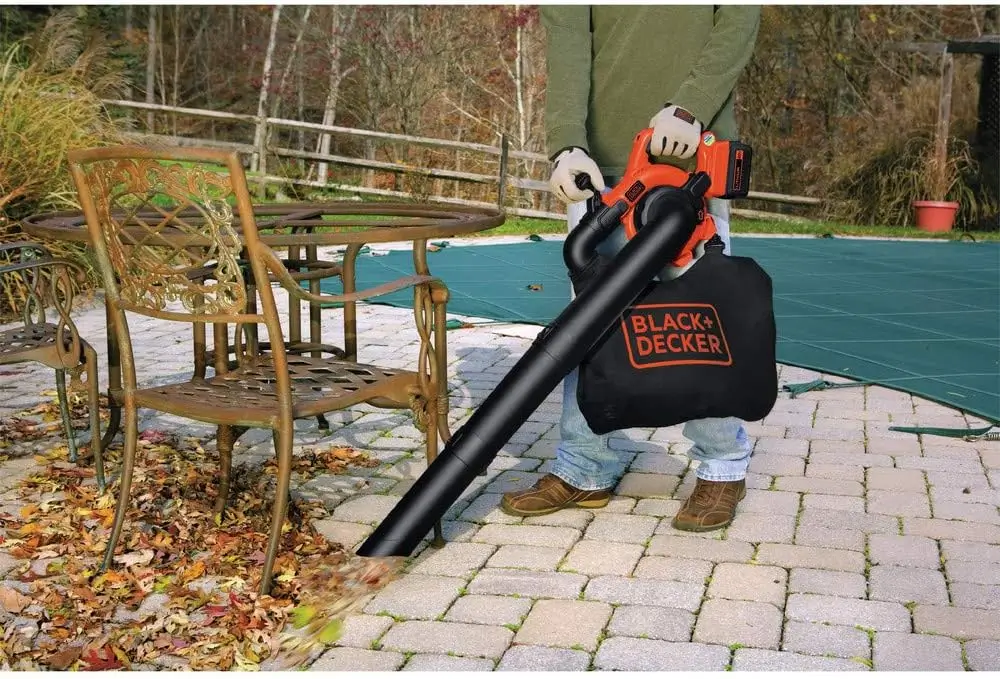
For precision pH management, the Sonkir Soil 3-in-1 Meter provides instant readings of soil pH, moisture, and light levels, helping you make informed decisions about amendment applications. This affordable tool takes the guesswork out of soil analysis and ensures optimal growing conditions. Check availability and pricing on Amazon to add scientific precision to your lawn care approach.
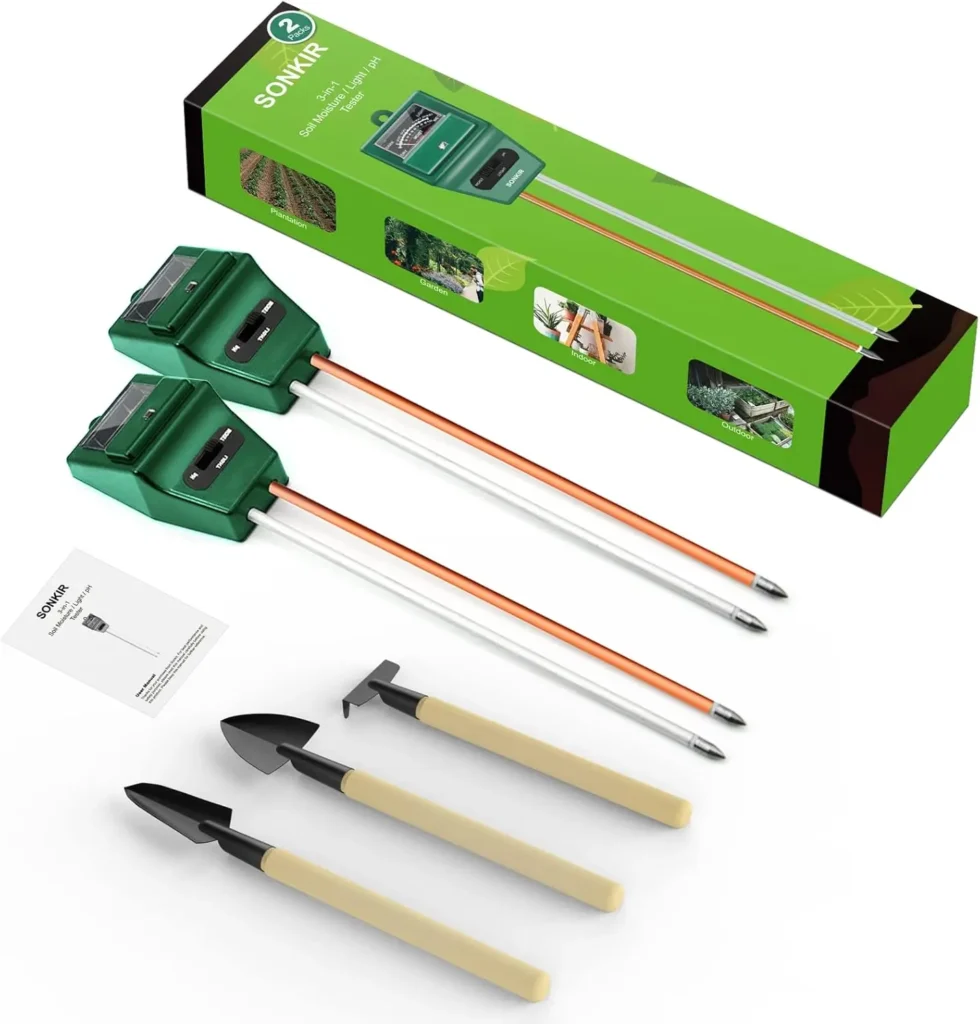
Future-Proofing Your Lawn: Long-Term Success Strategies
Building Soil Health Over Time
Successful lawn management involves building soil health through consistent, strategic applications rather than one-time fixes. This approach creates increasingly healthy growing conditions that support superior lawn quality over time.
Annual Amendment Schedules
Develop consistent annual schedules that provide regular soil enhancement without over-application. Typical schedules include spring compost top dressing followed by fall soil preparation activities.
Track application history to ensure balanced nutrition and avoid excessive buildup of any single amendment. This approach optimizes soil conditions while preventing waste and environmental impact.
Monitoring and Adjustment Strategies
Regular soil testing every 2-3 years guides amendment strategies and ensures applications address changing soil conditions. Soil chemistry evolves over time based on weather patterns, usage, and previous treatments.
Adjust amendment types and application rates based on testing results and lawn performance observations. This adaptive approach optimizes results while preventing problems before they become serious.
Integration with Overall Lawn Care
Soil amendments work best when integrated with comprehensive lawn care programs that address all aspects of grass health and growing conditions. This holistic approach maximizes amendment effectiveness while supporting overall lawn quality.
Fertilization Coordination
Coordinate amendment applications with fertilization schedules to prevent over-nutrition while ensuring adequate nutrient availability. Compost applications often reduce or eliminate the need for synthetic fertilizers.
Monitor grass response to combined amendment and fertilization programs, adjusting rates and timing based on actual results rather than theoretical recommendations.
Pest and Disease Management
Healthy soil created through proper amendment applications naturally suppresses many pest and disease problems while supporting grass vigor that resists remaining challenges.
Focus on preventive approaches that build natural resistance rather than reactive treatments that address problems after they develop. This strategy proves more effective and environmentally responsible.
Seasonal Lawn Care Calendar: Maximizing Amendment Effectiveness
Spring Action Plan (March-May)
Spring represents the critical season for establishing the foundation of lawn health through strategic soil amendments and preparation activities.
Early Spring Preparation (March)
Begin with soil testing to assess winter changes and guide spring amendment strategies. Soil conditions change over winter due to freeze-thaw cycles, precipitation, and organic matter decomposition.
Plan amendment applications based on testing results and lawn condition assessment. Order materials early to ensure availability during peak application periods.
Peak Application Period (April-May)
Apply compost top dressing during active grass growth but before peak summer stress begins. This timing allows maximum integration and grass response while avoiding heat stress complications.
Follow compost applications with appropriate watering that encourages integration without creating runoff or erosion problems.
Summer Maintenance (June-August)
Summer focuses on supporting lawn health through proper maintenance practices that protect spring amendment investments while preparing for fall enhancement opportunities.
Stress Management Strategies
Proper summer maintenance protects soil amendments and supports grass health during challenging growing conditions. Focus on practices that maintain soil moisture and reduce heat stress.
Avoid major soil disturbance during peak summer stress periods. Concentrate on maintenance activities that support existing amendments and growing conditions.
Fall Enhancement (September-November)
Fall provides optimal conditions for major soil improvement projects and preparation for the following growing season.
Active Growth Period (September-October)
Take advantage of moderate temperatures and increased moisture for compost applications that enhance lawn health before winter dormancy.
Fall amendments integrate effectively due to reduced stress conditions and extended mild weather typical of autumn months.
Winter Preparation (November)
Complete major soil preparation projects including topsoil additions for spring lawn installations. This timing allows materials to settle and integrate over winter months.
Ensure proper drainage around amended areas to prevent winter water accumulation that could damage soil structure or create ice damage.
Making the Final Decision: Your Action Plan
After considering all factors—from soil conditions and climate to budget and long-term goals—the choice between compost and topsoil for your lawn comes down to matching the right material to your specific needs and circumstances.
For Existing Lawn Enhancement: Choose compost for its superior soil-building properties, nutrient content, and environmental benefits. Regular compost applications transform average lawns into thriving, sustainable landscapes that require less water, fertilizer, and maintenance over time.
For New Lawn Installation: Combine quality topsoil with compost amendments to create the ideal growing medium that provides both structural foundation and biological activity necessary for rapid establishment and long-term success.
For Problem Area Solutions: Match your amendment choice to specific problems—use compost for drainage issues and soil health improvement, topsoil for leveling and volume requirements.
The most successful approach often involves strategic use of both materials in a planned sequence that builds soil health over time while addressing immediate needs. This investment in soil quality pays dividends through reduced maintenance requirements, improved environmental sustainability, and superior lawn appearance that enhances property value.
Remember that soil health represents the foundation of all successful landscaping. Whether you choose compost, topsoil, or a strategic combination of both, focus on quality materials, proper application techniques, and long-term soil building practices that create lasting value.
Your lawn represents a significant investment in your property’s beauty and value. Make amendment decisions based on science, quality, and long-term benefits rather than short-term costs. The reward will be a thriving, sustainable lawn that provides enjoyment and pride for years to come.
Ready to transform your lawn with the perfect soil amendments? Consider the best soil options for your raised bed gardens as well, creating a comprehensive landscape enhancement that maximizes your outdoor space’s potential.
Start your soil improvement journey today—your future lawn will thank you for the investment in its health and vitality.
